On this page we are assembling resources that might be useful for curricular units that take a look at death, its meaning and its representation in Mesoamerican cultures over time.
Pre-Columbian Examples
For the Nahuas, the Place of the Dead was called Mictlan, the ninth level of the underworld. Here is an article (in Spanish) about Mictlan. The authors tell us how, in pre-Hispanic Mesoamerica, death was embraced with respect and without fear. Cultural expressions relating to death are found in cosmology, philosophy, myths, and festivals. Life and death formed a duality. Some scholars believe that this duality is rooted in the changing seasons, wet and dry, and the way plant life responded, dying away in the dry season and being reborn in the wet season. A fundamental appreciation for water, especially rain, also derives from these observations about the seasons and their impact on life and death. Sunlight, similarly essential for life and growth, led to a recognition of the duality of day and night. Life depended upon the sun returning day after day.
Museums can be good places to look for artifacts that might bring insight for understanding the place of death in pre-Columbian cultures of Mesoamerica. The Rufino Tamayo museum is especially strong in its collection of items from the state of Veracruz, and from the Classic Period (200 C.E. to 750 C.E. in that region), which would not necessarily speak to the cultures of Oaxaca in the same period without further comparative research. But they can engage us and help us raise questions.

Pre-Columbian human cranium with alterations made after death. Not dated. From an exhibition in the Monte Albán museum. (S. Wood, 2011)
According to the curators who wrote the explanatory literature about the cranium above, it includes representations of a lizard head, of two serpent heads emerging from concentric circles, and three persons taking part in a sacred ritual devoted to the ancestors, making an offering to the earth and blowing a conch. The accompanying conch has carvings showing priests presenting an offering of the cranium on an altar, an image of the deity of rain, a person blowing a conch, a representation of the surface of the earth (monster-like), and the head of a serpent (also associated with the earth’s surface).
The cranium below, decorated with turquoise mosaic, is one of a kind. It is one of the more important pieces found in a tomb in Monte Albán. It is now held in the Museo de las Culturas de Oaxaca, upstairs in the Santo Domingo Cultural Center. Curators suggest that it was used as a container and employed in magical-religious activities, possibly by the people who were buried in the tomb, who seem to have characteristics of pre-Columbian priests.
A deep appreciation for ancestors marks Mesoamerican cultures, in general. Bones of ancestors were preserved. The remains of rulers were entombed and sometimes dug up and carried to another location when populations shifted.
In this rendition of a pre-Columbian lady (queen or princess), below, made in Oaxaca by muralist Arturo García Bustos, we see her glyphic name was One-Death. Death was a symbol in the calendar.
Portraiture

A modern take-off on the colonial portrait of the famous Mexican nun, Sor Juana Inés de la Cruz (R. Haskett, Oaxaca, 2005)
José Guadalupe Posada
The most famous Mexican artist who worked with skulls and skeletons in his art, quite liberally, was Posada, who was active in the late nineteenth and early twentieth centuries. His influence on Mexican art has been huge. Take a look, for example, at the MoMA website’s feature on Posada: http://www.moma.org/collection/artist.php?artist_id=4707
Twenty-first Century Representations
One will see many skulls and skeletons around Oaxaca today, in many forms.

Skeletons at play. NEH Summer Scholar Anna Reed’s photo of a building in the neighborhood of Jalatlaco, Oaxaca city. (2011)

The mustache, sombrero, and sarape are reminiscent of the Mexican Revolution of 1910 and therefore of Posada’s work. Jalatlaco mural of 2009. (Photo, S. Wood)

Detail of a skeleton wearing red high heels and stepping on skulls, Jalatlaco mural. (S. Wood, 2011)

Detail, a Moctezuma-like figure in skeleton with a feathered headdress. Jalatlaco mural. (S. Wood, 2011)
The Day of the Dead in Oaxaca is also an especially popular holiday, where all the graveyards are occupied by families going to commune with their deceased relatives, playing live music and eating meals in the cemeteries.
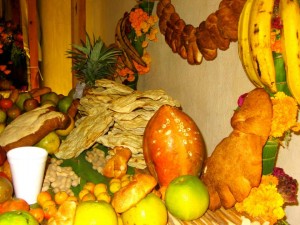
One of many Day of the Dead altars on display at the Biblioteca de Investigación Juan de Córdova, Oaxaca (S. Wood, Nov. 2013)
Street Art with Skulls and Skeletons

A protest against Halloween influences in the Day of the Dead activities in Oaxaca (S. Wood, Nov. 2013)
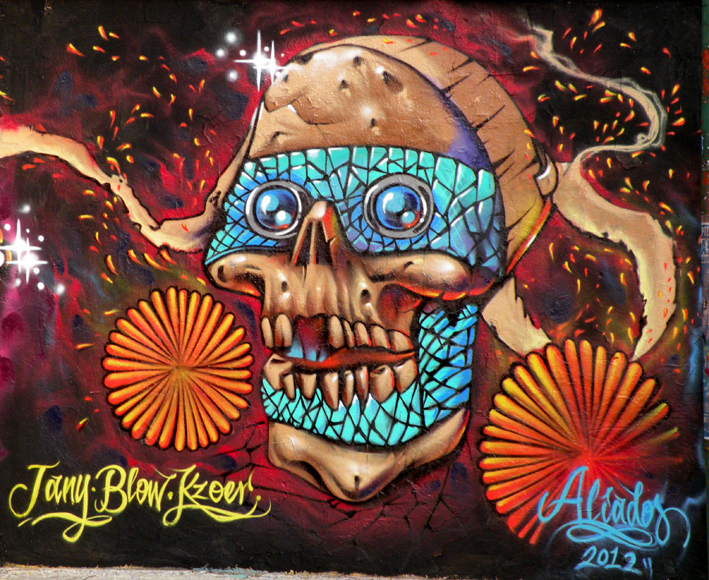
Turquoise-covered skull, reminiscent of pre-Columbian artifacts. By street artist, Kazo, Oaxaca. (Photo, Itandehui F. Orozco, 2012)
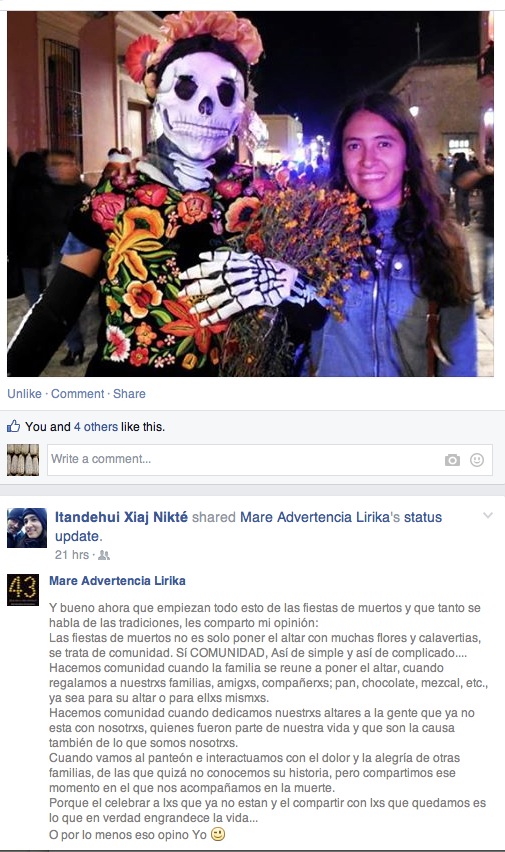
This is a message from the Zapotec rapper, Mare, about the meaning of the Day of the Dead from her point of view. On the right is the art historian and archivist of urban art, Itandehui. Shared on Facebook, Oct 31, 2014. (With their permission.)



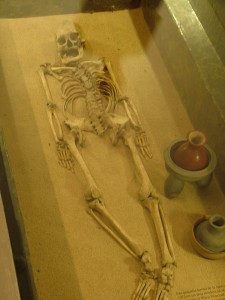
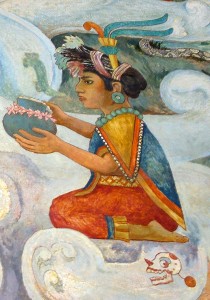



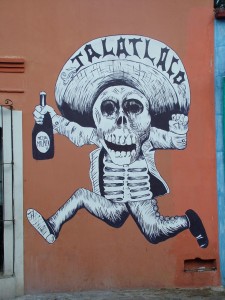
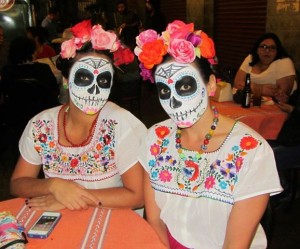


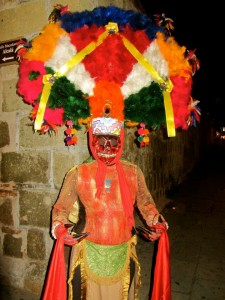




![Note the little skulls on the women's chest and throat. [San Agustín Etla. S. Wood, Nov. 2013.]](https://blogs.uoregon.edu/mesoinstitute/files/2013/12/IMG_0362-1doek4c-300x225.jpg)